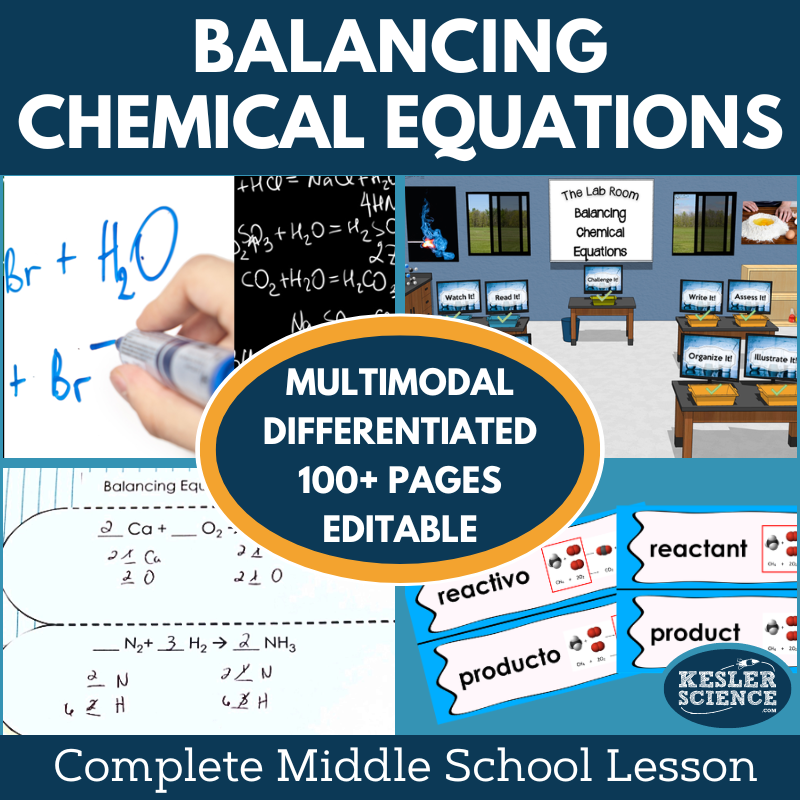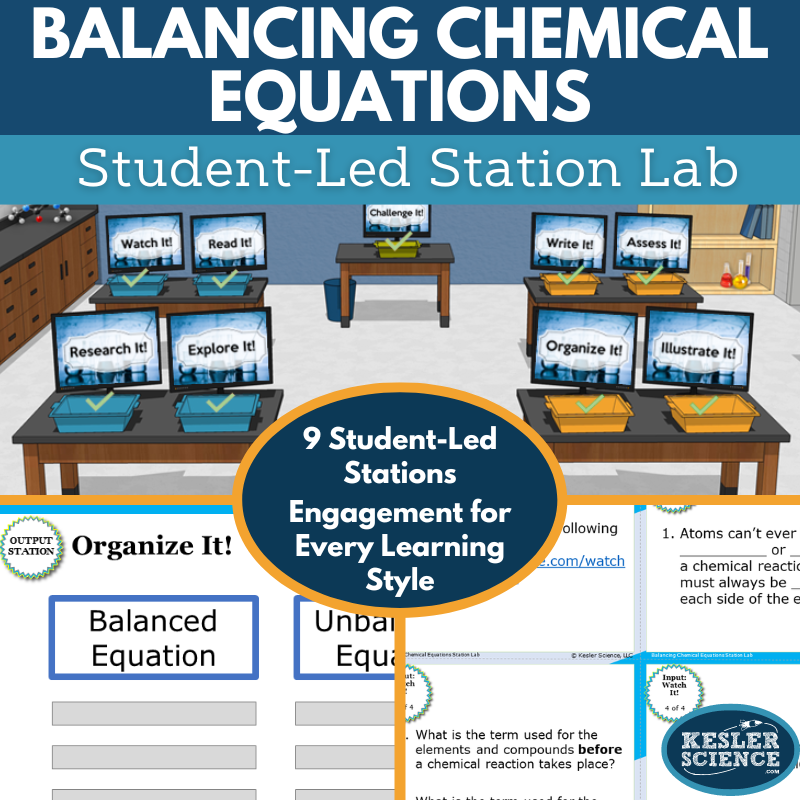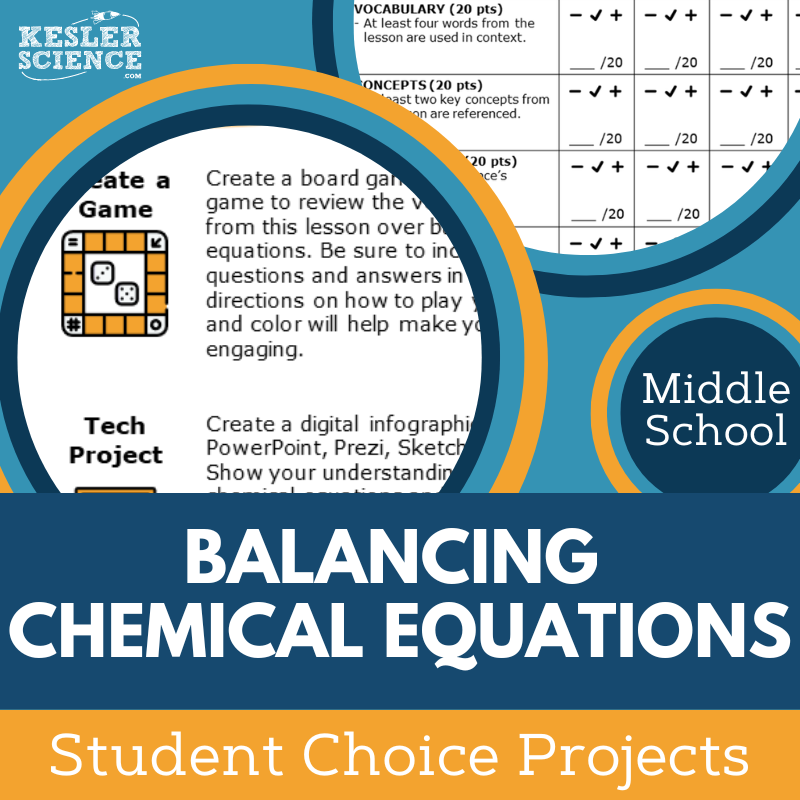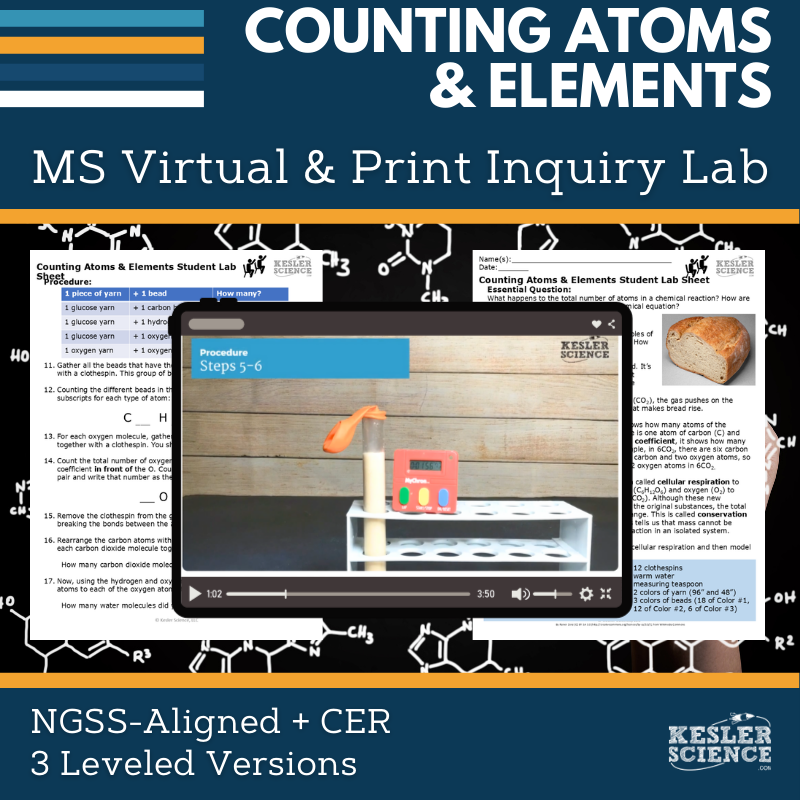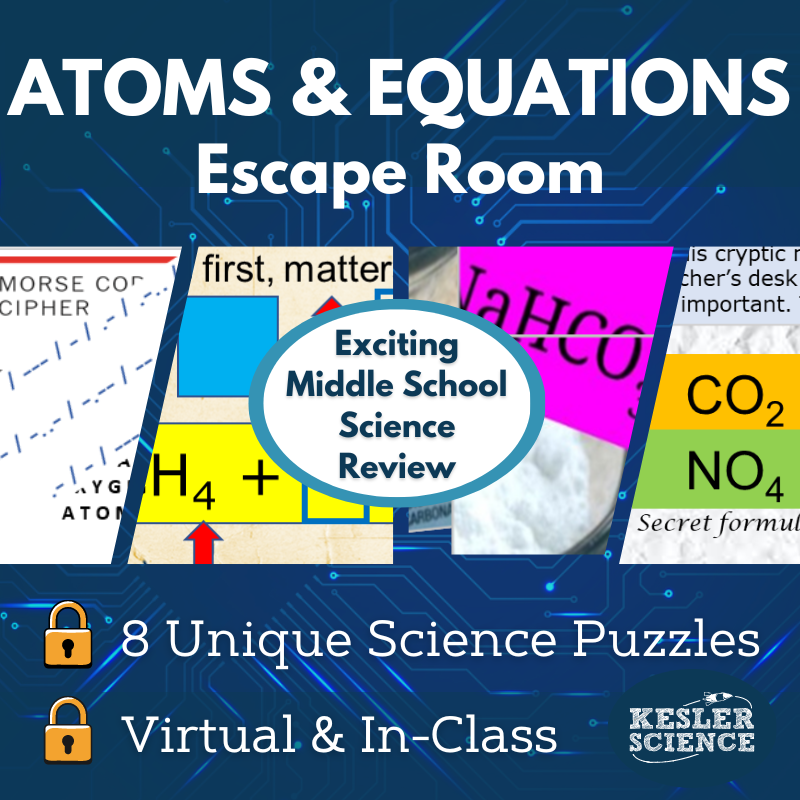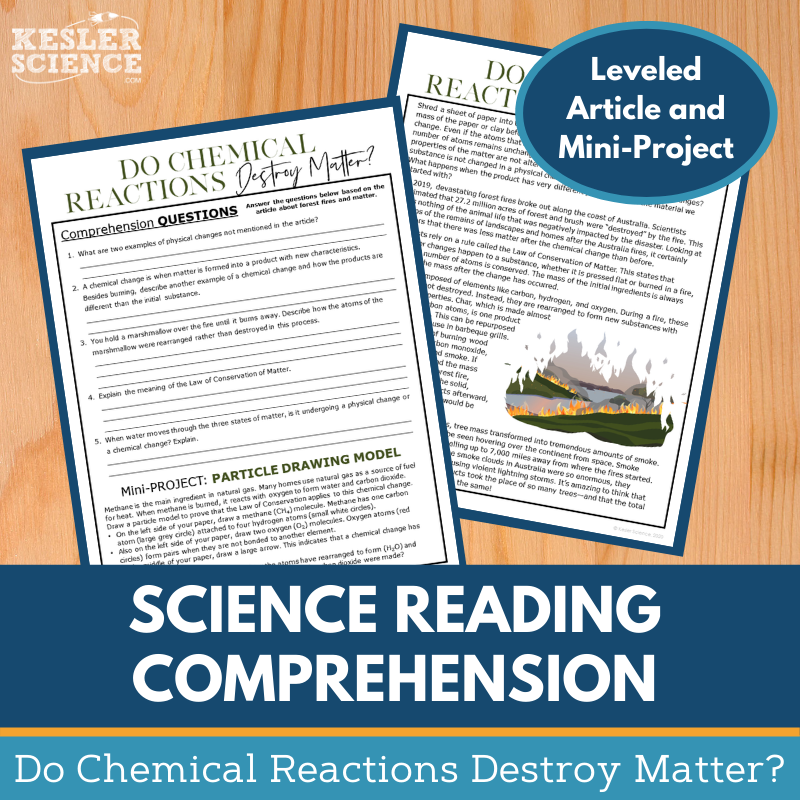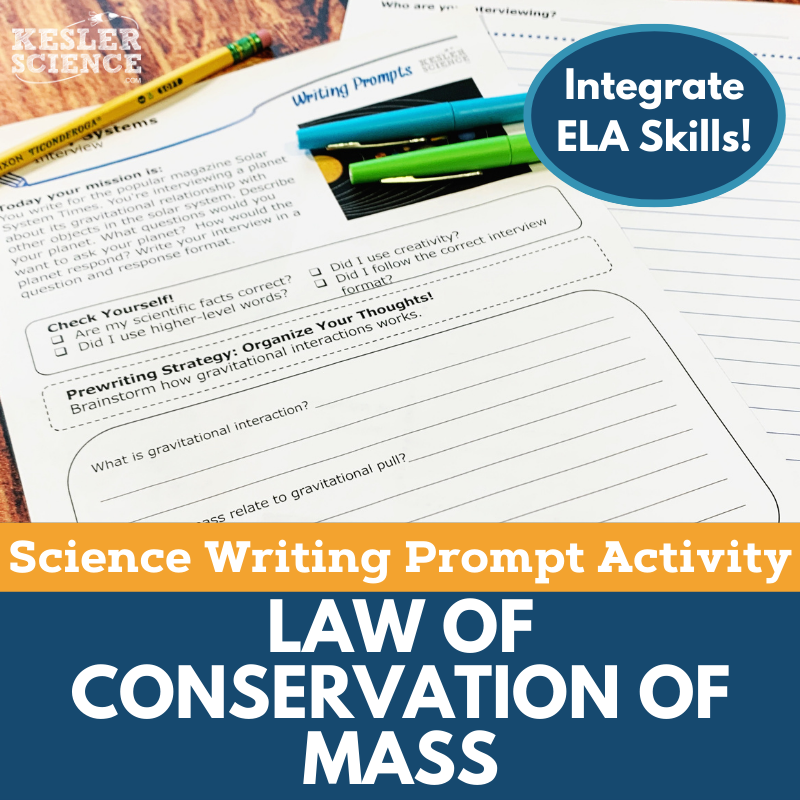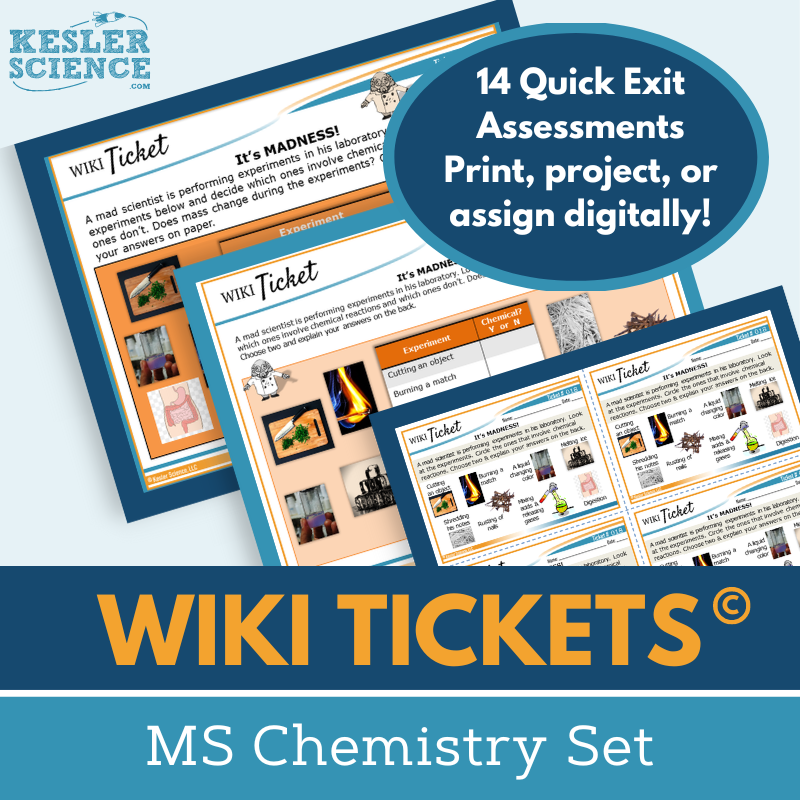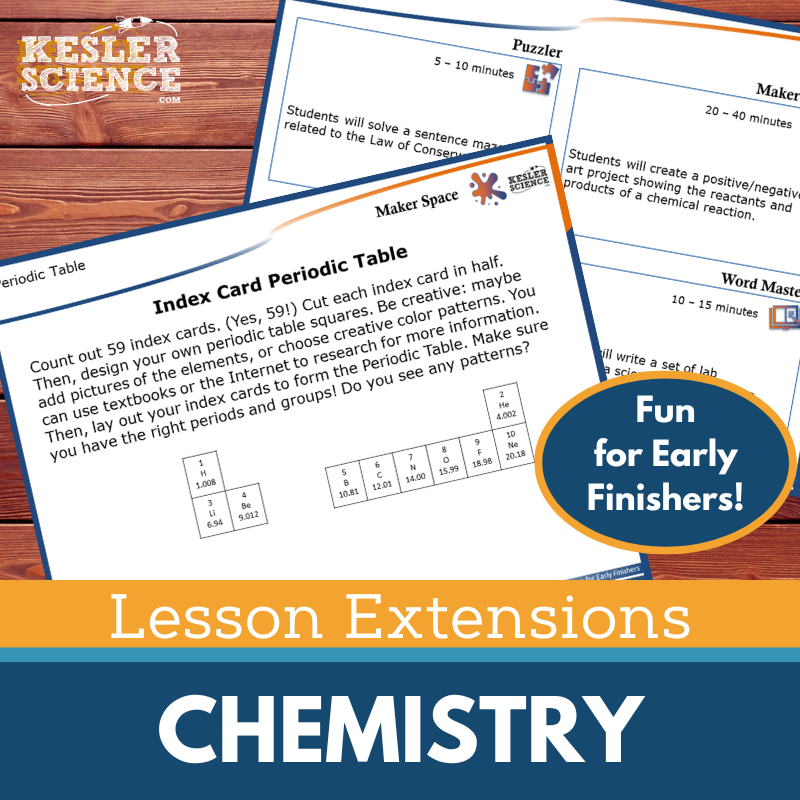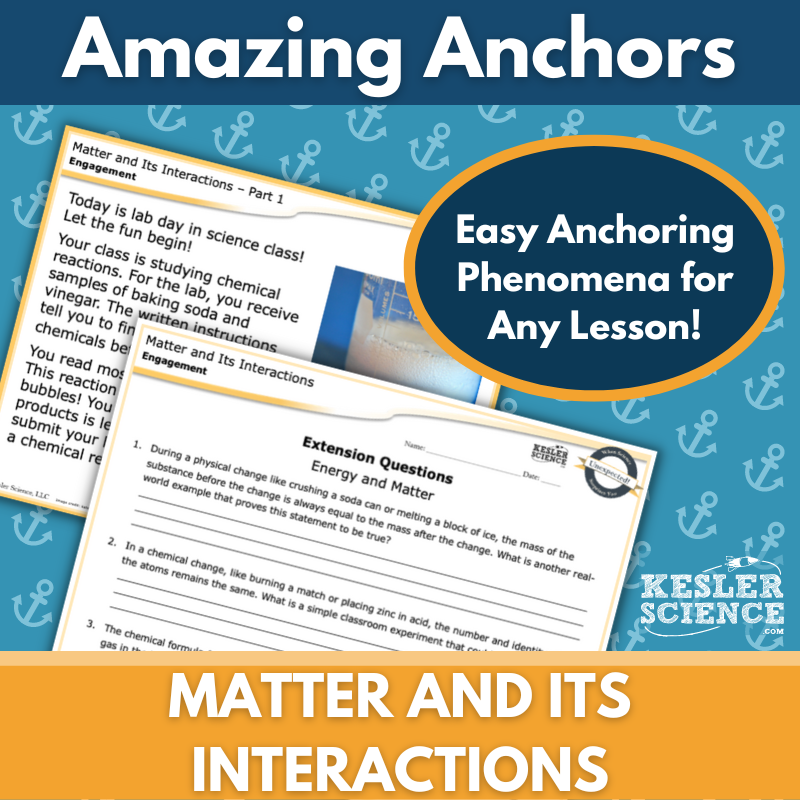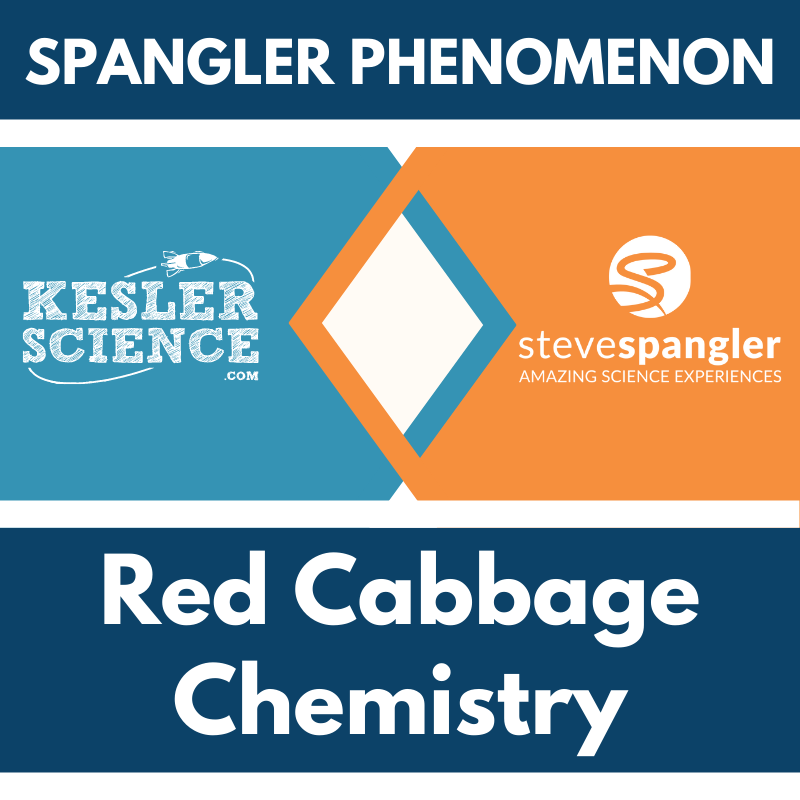Mass & Chemical Reactions Activities for Middle School Science
This engaging 5E lesson helps middle school students master balancing chemical equations through interactive, student-led learning. The resources below will give students a comprehensive understanding of mass and chemical reactions. All of the following materials are also included in the Kesler Science Membership.
The Kesler Science Balancing Chemical Equations 5E Lesson is a comprehensive, editable unit designed for middle school students. It includes presentations, worksheets, choice projects, and assessments, requiring minimal prep while supporting differentiated, student-led learning. The lesson aligns with NGSS and TEKS standards and emphasizes multimodal instruction to keep students engaged.
Following the 5E Model, the unit begins with engagement activities, including vocabulary in English and Spanish, class discussions, and interactive activities. The exploration phase features a differentiated, student-led station lab with nine stations, incorporating hands-on experiments, reading passages, research tasks, video discussions, and various output activities like writing, illustrating, and categorizing information. An optional challenge station extends learning for early finishers.
Explanation materials include editable PowerPoints, interactive notebooks, and note-taking templates in print and digital formats. Students elaborate through choice projects that deepen their understanding of balancing equations. Evaluation consists of STAAR 2.0-aligned assessments, review questions, and worksheets for practice and discussion.
This resource is fully adaptable for virtual learning, with digital station labs and interactive notebooks ensuring accessibility in any setting.
The Kesler Science Balancing Chemical Equations 5E Lesson is a comprehensive, editable unit designed for middle school students. It includes presentations, worksheets, choice projects, and assessments, requiring minimal prep while supporting differentiated, student-led learning. The lesson aligns with NGSS and TEKS standards and emphasizes multimodal instruction to keep students engaged.
Following the 5E Model, the unit begins with engagement activities, including vocabulary in English and Spanish, class discussions, and interactive activities. The exploration phase features a differentiated, student-led station lab with nine stations, incorporating hands-on experiments, reading passages, research tasks, video discussions, and various output activities like writing, illustrating, and categorizing information. An optional challenge station extends learning for early finishers.
Explanation materials include editable PowerPoints, interactive notebooks, and note-taking templates in print and digital formats. Students elaborate through choice projects that deepen their understanding of balancing equations. Evaluation consists of STAAR 2.0-aligned assessments, review questions, and worksheets for practice and discussion.
This resource is fully adaptable for virtual learning, with digital station labs and interactive notebooks ensuring accessibility in any setting.
Engage your middle school students in balancing chemical equations with this interactive, student-led station lab. Designed to promote independent learning, this modular activity guides students in recognizing balanced equations and understanding the law of conservation.
Featuring eight differentiated stations and a bonus challenge station, students explore concepts through hands-on tasks, videos, readings, and digital activities. Stations include researching information, watching instructional videos, reading passages with differentiated options in English and Spanish, and engaging in interactive exercises such as organizing manipulatives, illustrating concepts, and responding to written prompts.
This low-prep resource is adaptable for in-class and virtual learning, providing students with multiple ways to absorb and demonstrate their understanding while the teacher facilitates their exploration.
Engage your middle school students in balancing chemical equations with this interactive, student-led station lab. Designed to promote independent learning, this modular activity guides students in recognizing balanced equations and understanding the law of conservation.
Featuring eight differentiated stations and a bonus challenge station, students explore concepts through hands-on tasks, videos, readings, and digital activities. Stations include researching information, watching instructional videos, reading passages with differentiated options in English and Spanish, and engaging in interactive exercises such as organizing manipulatives, illustrating concepts, and responding to written prompts.
This low-prep resource is adaptable for in-class and virtual learning, providing students with multiple ways to absorb and demonstrate their understanding while the teacher facilitates their exploration.
The Balancing Chemical Equations Student Choice Projects lesson allows middle school students to demonstrate their understanding through a project that fits their preferred output style. A project page outlines six student-led options plus a “design your own” project, with an editable rubric for teacher, peer, or self-assessment.
These flexible, multimodal projects offer creative ways for students to engage with the content. Two versions of the project page support differentiation, with modified options for students needing remediation and challenge opportunities for advanced learners. Teachers can adjust the rubric to fit their grading needs.
The projects require standard classroom supplies like paper, markers, and scissors, with many options available for digital completion. Some crafting materials may be useful for model-building.
The Balancing Chemical Equations Student Choice Projects lesson allows middle school students to demonstrate their understanding through a project that fits their preferred output style. A project page outlines six student-led options plus a “design your own” project, with an editable rubric for teacher, peer, or self-assessment.
These flexible, multimodal projects offer creative ways for students to engage with the content. Two versions of the project page support differentiation, with modified options for students needing remediation and challenge opportunities for advanced learners. Teachers can adjust the rubric to fit their grading needs.
The projects require standard classroom supplies like paper, markers, and scissors, with many options available for digital completion. Some crafting materials may be useful for model-building.
The Counting Atoms and Elements Inquiry Lab aligns with NGSS MS-PS1-5, helping students develop and use a model to describe how the total number of atoms remains unchanged in a chemical reaction, ensuring mass conservation. Students will observe cellular respiration, analyze its chemical equation, and create a model demonstrating mass conservation.
This lab is available in both print and digital formats. The hands-on print version allows students to conduct the experiment using simple materials such as yeast, sugar, a test tube, and a balloon, while the digital version includes an interactive PowerPoint compatible with Google Slides, MS Teams, Schoology, and Canvas. A pre-recorded video guides students through the experiment, making it accessible even without materials.
The lab includes comprehension questions, Claim-Evidence-Reasoning (C.E.R.) prompts, and reflection activities. Differentiation is built in with three levels: Dependent (guided inquiry), Modified (structured with sentence stems or multiple-choice), and Independent (student-led exploration).
Teacher resources include editable PowerPoints, answer keys, and flexible materials designed to engage middle school students. The files are available in multiple formats, ensuring ease of use and customization for any classroom setting.
The Counting Atoms and Elements Inquiry Lab aligns with NGSS MS-PS1-5, helping students develop and use a model to describe how the total number of atoms remains unchanged in a chemical reaction, ensuring mass conservation. Students will observe cellular respiration, analyze its chemical equation, and create a model demonstrating mass conservation.
This lab is available in both print and digital formats. The hands-on print version allows students to conduct the experiment using simple materials such as yeast, sugar, a test tube, and a balloon, while the digital version includes an interactive PowerPoint compatible with Google Slides, MS Teams, Schoology, and Canvas. A pre-recorded video guides students through the experiment, making it accessible even without materials.
The lab includes comprehension questions, Claim-Evidence-Reasoning (C.E.R.) prompts, and reflection activities. Differentiation is built in with three levels: Dependent (guided inquiry), Modified (structured with sentence stems or multiple-choice), and Independent (student-led exploration).
Teacher resources include editable PowerPoints, answer keys, and flexible materials designed to engage middle school students. The files are available in multiple formats, ensuring ease of use and customization for any classroom setting.
The Atoms and Equations Escape Room is an engaging, student-centered activity designed to help students demonstrate their understanding of counting atoms and determining whether an equation is balanced. Aligned with TEKS and NGSS standards, this escape room challenges students to recognize chemical formulas, investigate evidence of chemical reactions, and model how the total number of atoms remains unchanged in a chemical reaction.
Teachers have full control over the eight independent puzzles, allowing customization based on class time and student needs. The activity can be conducted using simple manila envelopes or a more authentic escape room setup with locks and storage boxes. A digital version is available for online learning through PowerPoint or Google Slides, with a printable option for at-home use.
Included in this resource are teacher directions, a detailed answer key, editable templates, a digital answer sheet, and a video challenge to enhance engagement. Students will work through unique puzzles with printable props, reward templates, and themed signs to capture their success. This interactive learning experience will keep students engaged and excited about mastering chemical formulas and reactions.
The Atoms and Equations Escape Room is an engaging, student-centered activity designed to help students demonstrate their understanding of counting atoms and determining whether an equation is balanced. Aligned with TEKS and NGSS standards, this escape room challenges students to recognize chemical formulas, investigate evidence of chemical reactions, and model how the total number of atoms remains unchanged in a chemical reaction.
Teachers have full control over the eight independent puzzles, allowing customization based on class time and student needs. The activity can be conducted using simple manila envelopes or a more authentic escape room setup with locks and storage boxes. A digital version is available for online learning through PowerPoint or Google Slides, with a printable option for at-home use.
Included in this resource are teacher directions, a detailed answer key, editable templates, a digital answer sheet, and a video challenge to enhance engagement. Students will work through unique puzzles with printable props, reward templates, and themed signs to capture their success. This interactive learning experience will keep students engaged and excited about mastering chemical formulas and reactions.
This Science Reading Comprehension Lesson explores how the total number of atoms remains constant in a chemical reaction, ensuring mass is conserved. Students read a nonfiction article on chemical reactions, answer comprehension questions, and create a particle drawing model.
Designed for middle school students (grades 6-8) and advanced 5th graders, the resource includes a leveled passage (Lexile 1100-1300), five to seven comprehension questions, and a hands-on mini-project. A Cornell notes template is also provided.
Ideal for sub plans, extra credit, ISS, or whole-class instruction, this resource fosters science literacy, critical thinking, and classroom discussions. It is compatible with virtual learning platforms like Google Classroom, MS Teams, Schoology, and Canvas, allowing students to respond digitally.
This Science Reading Comprehension Lesson explores how the total number of atoms remains constant in a chemical reaction, ensuring mass is conserved. Students read a nonfiction article on chemical reactions, answer comprehension questions, and create a particle drawing model.
Designed for middle school students (grades 6-8) and advanced 5th graders, the resource includes a leveled passage (Lexile 1100-1300), five to seven comprehension questions, and a hands-on mini-project. A Cornell notes template is also provided.
Ideal for sub plans, extra credit, ISS, or whole-class instruction, this resource fosters science literacy, critical thinking, and classroom discussions. It is compatible with virtual learning platforms like Google Classroom, MS Teams, Schoology, and Canvas, allowing students to respond digitally.
The Law of Conservation of Mass Science Writing Prompt Activity engages middle school students in a creative poetry-based exercise to reinforce their understanding of physical science. Aligned with NGSS MS-PS1-5, this activity helps students develop models to describe how the total number of atoms remains unchanged in a chemical reaction, ensuring mass is conserved. Designed for both in-person and virtual learning, this low-prep, student-centered resource encourages science reasoning and exploration while enhancing writing skills.
This resource includes teacher directions with project ideas and rubrics, projection and print-friendly handouts, and a digital PowerPoint version adaptable for Google Slides. The activity works well as a cross-curricular assignment, pre-test assessment, student choice project, or enrichment for early finishers. It is also ideal for extra credit, make-up work, differentiation, or TELPAS writing samples. Displayed on a bulletin board or compiled in an anthology, these writing prompts offer an engaging and meaningful way to reinforce key science concepts.
The Law of Conservation of Mass Science Writing Prompt Activity engages middle school students in a creative poetry-based exercise to reinforce their understanding of physical science. Aligned with NGSS MS-PS1-5, this activity helps students develop models to describe how the total number of atoms remains unchanged in a chemical reaction, ensuring mass is conserved. Designed for both in-person and virtual learning, this low-prep, student-centered resource encourages science reasoning and exploration while enhancing writing skills.
This resource includes teacher directions with project ideas and rubrics, projection and print-friendly handouts, and a digital PowerPoint version adaptable for Google Slides. The activity works well as a cross-curricular assignment, pre-test assessment, student choice project, or enrichment for early finishers. It is also ideal for extra credit, make-up work, differentiation, or TELPAS writing samples. Displayed on a bulletin board or compiled in an anthology, these writing prompts offer an engaging and meaningful way to reinforce key science concepts.
The WIKI Tickets© Chemistry Set provides engaging, flexible formative assessments for 6th-8th grade science, offering multiple ways to check student understanding. This set includes 14 topics, each available in five formats: a full-screen projection version, three printable handout sizes, and an interactive digital version compatible with PowerPoint and Google Slides.
Aligned with NGSS and TEKS standards, these assessments ensure comprehensive coverage, with some topics featuring multiple tickets. A bonus table of contents file is included for easy alignment reference. Designed for both in-person and virtual learning, WIKI Tickets© can be used as exit tickets, bellringers, or quick checks. Students can respond on their own paper, printed handouts, or digital copies in a 1:1 or remote setting.
Covering key topics such as atomic structure, chemical changes, density, and periodic table arrangement, these colorful assessments help you gauge student progress in an engaging way.
The WIKI Tickets© Chemistry Set provides engaging, flexible formative assessments for 6th-8th grade science, offering multiple ways to check student understanding. This set includes 14 topics, each available in five formats: a full-screen projection version, three printable handout sizes, and an interactive digital version compatible with PowerPoint and Google Slides.
Aligned with NGSS and TEKS standards, these assessments ensure comprehensive coverage, with some topics featuring multiple tickets. A bonus table of contents file is included for easy alignment reference. Designed for both in-person and virtual learning, WIKI Tickets© can be used as exit tickets, bellringers, or quick checks. Students can respond on their own paper, printed handouts, or digital copies in a 1:1 or remote setting.
Covering key topics such as atomic structure, chemical changes, density, and periodic table arrangement, these colorful assessments help you gauge student progress in an engaging way.
Lesson Extensions provide engaging, student-choice activities designed to challenge early finishers while reinforcing critical thinking and creativity. These activities help wrap up lessons, fill downtime during testing, and keep students engaged with rigorous yet enjoyable learning opportunities aligned to NGSS and TEKS chemistry standards.
Each extension includes four interactive components: Puzzler for problem-solving, Maker Space for hands-on STEAM activities, Tech Connection for digital media demonstrations, and Word Master for creative writing. Teacher directions, answer keys, and both print and projection versions ensure flexibility in the classroom.
Covering topics such as atomic structures, chemical reactions, the periodic table, and synthetic materials, these extensions provide high-level enrichment for independent learners ready to explore chemistry concepts more deeply.
Lesson Extensions provide engaging, student-choice activities designed to challenge early finishers while reinforcing critical thinking and creativity. These activities help wrap up lessons, fill downtime during testing, and keep students engaged with rigorous yet enjoyable learning opportunities aligned to NGSS and TEKS chemistry standards.
Each extension includes four interactive components: Puzzler for problem-solving, Maker Space for hands-on STEAM activities, Tech Connection for digital media demonstrations, and Word Master for creative writing. Teacher directions, answer keys, and both print and projection versions ensure flexibility in the classroom.
Covering topics such as atomic structures, chemical reactions, the periodic table, and synthetic materials, these extensions provide high-level enrichment for independent learners ready to explore chemistry concepts more deeply.
This Amazing Anchors Phenomenon Lesson introduces chemical reactions through an engaging, real-world approach. It features an introductory reading centered on a science lab, followed by comprehension and extension questions to prepare students for further learning. An explanatory reading simplifies the science behind baking soda and vinegar reactions, with additional questions to reinforce understanding.
This NGSS-aligned resource (MS PS1-5) includes teacher directions with answer keys, projection slides, editable digital materials for LMS platforms, and printable handouts in various formats. Designed to complement a main lesson, these readings work well as supplements in 5E lesson plans, particularly in the Engagement and Elaborate phases. A differentiated version supports students with sentence starters and simplified language, ensuring accessibility for all learners. Available in both print and digital formats, this no-prep lesson is adaptable for in-person or distance learning.
This Amazing Anchors Phenomenon Lesson introduces chemical reactions through an engaging, real-world approach. It features an introductory reading centered on a science lab, followed by comprehension and extension questions to prepare students for further learning. An explanatory reading simplifies the science behind baking soda and vinegar reactions, with additional questions to reinforce understanding.
This NGSS-aligned resource (MS PS1-5) includes teacher directions with answer keys, projection slides, editable digital materials for LMS platforms, and printable handouts in various formats. Designed to complement a main lesson, these readings work well as supplements in 5E lesson plans, particularly in the Engagement and Elaborate phases. A differentiated version supports students with sentence starters and simplified language, ensuring accessibility for all learners. Available in both print and digital formats, this no-prep lesson is adaptable for in-person or distance learning.
This Spangler Phenomenon lesson on chemical reactions, mass, and conservation features an exclusive Steve Spangler video to engage students in exploring the relationship between reactants and products in a chemical reaction. The interactive investigation challenges students with the question: What is the relationship between the atoms of the reactants and the atoms of the products after a chemical reaction?
Designed within the 5E framework and aligned to NGSS middle school physical science, this lesson integrates the crosscutting concept of structure and function and the science and engineering practice of obtaining, evaluating, and communicating information.
In Think Like a Scientist, students analyze chemical reactions through an inspiring Steve Spangler video before conducting their own cabbage chemistry experiment. Study Like a Scientist encourages students to gather facts from an engaging article, with opportunities to expand learning through additional hands-on activities like Station Labs. In Work Like a Scientist, students refine their understanding after watching an explanation video, then demonstrate their knowledge through writing, drawing, or building activities.
The lesson includes complete teacher directions, student handouts, two Steve Spangler videos, clear presentation slides in standard and digital interactive formats, and PowerPoints that seamlessly upload to Google Slides. Vimeo links ensure ad-free video access. File formats include PowerPoint and PDF, with Google Slides compatibility.
This Spangler Phenomenon lesson on chemical reactions, mass, and conservation features an exclusive Steve Spangler video to engage students in exploring the relationship between reactants and products in a chemical reaction. The interactive investigation challenges students with the question: What is the relationship between the atoms of the reactants and the atoms of the products after a chemical reaction?
Designed within the 5E framework and aligned to NGSS middle school physical science, this lesson integrates the crosscutting concept of structure and function and the science and engineering practice of obtaining, evaluating, and communicating information.
In Think Like a Scientist, students analyze chemical reactions through an inspiring Steve Spangler video before conducting their own cabbage chemistry experiment. Study Like a Scientist encourages students to gather facts from an engaging article, with opportunities to expand learning through additional hands-on activities like Station Labs. In Work Like a Scientist, students refine their understanding after watching an explanation video, then demonstrate their knowledge through writing, drawing, or building activities.
The lesson includes complete teacher directions, student handouts, two Steve Spangler videos, clear presentation slides in standard and digital interactive formats, and PowerPoints that seamlessly upload to Google Slides. Vimeo links ensure ad-free video access. File formats include PowerPoint and PDF, with Google Slides compatibility.
"Explories: CAUGHT” is an NGSS unit that immerses students in a Forensics Academy, where they learn chemistry principles and evidence-gathering skills to solve a non-violent crime. Through this interactive experience, students progress through training levels, earning badges as they develop investigative techniques. They begin with an introduction to the nervous system and sensory processes before moving on to crime scene evidence collection and analysis. Chemistry lessons equip students with the skills to examine substances like lipstick and blood, culminating in the creation of a Rookie Handbook that aids them in solving their first case with a field partner.
This unit includes day-by-day teacher instructions, two unit projects, six station labs, eight inquiry labs, six 5E lessons, student activity pages, project-based and traditional assessments, rubrics for feedback and standards-based grading, journaling and synthesis activities, and two training videos on how to use the files. It aligns with NGSS standards related to atomic structure, chemical reactions, conservation of mass, energy transfer, and sensory processing.
"Explories: CAUGHT” is an NGSS unit that immerses students in a Forensics Academy, where they learn chemistry principles and evidence-gathering skills to solve a non-violent crime. Through this interactive experience, students progress through training levels, earning badges as they develop investigative techniques. They begin with an introduction to the nervous system and sensory processes before moving on to crime scene evidence collection and analysis. Chemistry lessons equip students with the skills to examine substances like lipstick and blood, culminating in the creation of a Rookie Handbook that aids them in solving their first case with a field partner.
This unit includes day-by-day teacher instructions, two unit projects, six station labs, eight inquiry labs, six 5E lessons, student activity pages, project-based and traditional assessments, rubrics for feedback and standards-based grading, journaling and synthesis activities, and two training videos on how to use the files. It aligns with NGSS standards related to atomic structure, chemical reactions, conservation of mass, energy transfer, and sensory processing.
Year-Round Resources
These year-round activities will increase your students' understanding of many middle school science topics. All of these activities are also included in the Kesler Science Membership.
Visual Data & Graphing
You're not alone if your students struggle with understanding graphs, charts, and tables. It's a skill that takes an enormous amount of practice. This resource will help students build a strong foundation in analyzing data and creating their own data visualizations.
Bell Ringers and Warm-Ups
These middle school science bell ringers are an excellent way to engage your students as soon as they walk into your classroom. This comprehensive FULL YEAR resource includes everything you need to start off each science class with an interesting warm-up activity.
Review Board Games
Each game board has been carefully designed to keep students engaged. There are 10 different action spaces on each board and dozens of question cards. All of the actions are related to science concepts and keep the students motivated throughout the game.
Each game is ready to play. Simply print out the board and the cards and let the students enjoy reviewing nine different units.
Essential Questions and Standards
Below are the essential questions and standards associated with the lessons and activities included in the mass and chemical reactions unit. This topic is only one of more than 100 middle school science topics included in the Kesler Science Membership.
-
What are the different parts of the chemical equation?
-
How can we tell if a chemical equation is balanced or not?
-
How does balancing equations relate to the law of conservation of mass?
-
NGSS - MS-PS1-5 Mass & Chemical Reactions
Kesler Science Membership
Imagine never having to search for another middle school science lesson again. The membership gives you access to ALL of the Kesler Science products in one place (Yes, including everything above).
Say goodbye to long hours of lesson prep.

